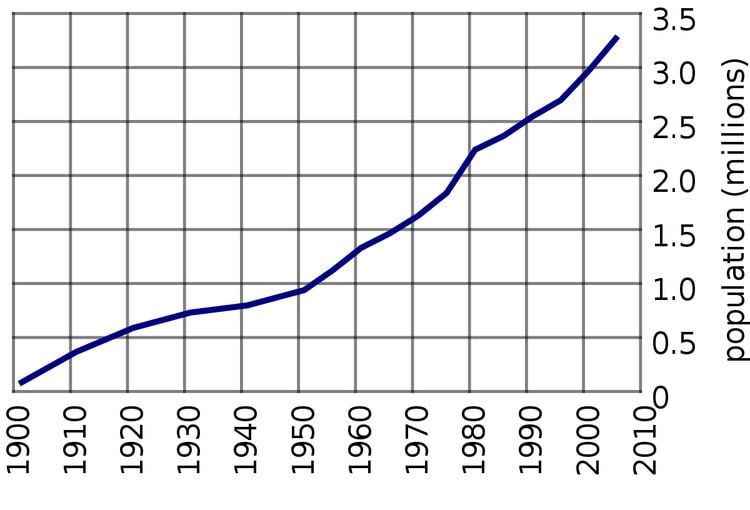 | ||
Alberta has experienced a relatively high rate of growth in recent years, due in large part to its economy. Between 2003 and 2004, the province saw high birthrates (on par with some larger provinces such as British Columbia), relatively high immigration, and a high rate of interprovincial migration when compared to other provinces. Approximately 81% of the population live in urban areas and only about 19% live in rural areas. The Calgary–Edmonton Corridor is the most urbanized area in Alberta and is one of Canada's four most urban regions. Many of Alberta's cities and towns have also experienced high rates of growth in recent history. From a population of 73,022 in 1901, Alberta has grown to 3,645,257 in 2011 and in the process has gone from less than 1.5% of Canada's population to 10.9%.
Contents
Census metropolitan areas
As of the 2011 census, Alberta had two census metropolitan areas (CMAs) recognized by Statistics Canada. The following is a list of the recent population history of the Calgary and Edmonton CMAs.
CMA notes:
Census subdivisions
As of the 2006 census, Alberta had 453 census subdivisions (municipalities and municipal equivalents) recognized by Statistics Canada. The following is a list of those census subdivisions with a population of 10,000 or greater.
Ethnic origins
The ethnicities most commonly reported in the 2011 Census are shown in the table below. The percentages add up to more than 100% because of dual responses (e.g. "Irish-Canadian" generates an entry in both the category "Irish" and the category "Canadian").
Other Ethnic Groups
In addition to the groups listed above, the next most commonly reported (counting both single and multiple responses) were:
Languages
Of the 3,547,680 singular responses to the 2011 census question concerning mother tongue, the languages most commonly reported were:
Note: "n.i.e.": not included elsewhere
Other Languages
In addition to the table above, other mother tongues include:
Mother tongues of more than 355 persons (0.01%) are listed.
In addition to the single-language responses detailed above, about 62,505 people reported having more than one mother tongue. There were 49,970 responses of both English and a non-official language; 2,945 of both French and a non-official language; 8,410 of both English and French; and 1,185 of English, French and a non-official language.
Immigration
The 2011 Canadian census counted a total of 644,115 immigrants living in Alberta, 257,230 of whom arrived after 2001.
The most common countries of birth for immigrants living in Alberta were:
Other Places of Origin
In addition to the countries listed in the table above, there were also about:
{Countries of birth for more than 1,784 persons (0.05%) are shown.}
Internal migration
A total of 469,095 people moved to Alberta from other parts of Canada between 1996 and 2006 while 261,500 people moved in the opposite direction. These movements resulted in a net influx of 51,235 people from British Columbia, 42,180 people from Saskatchewan, 31,425 people from Ontario, 23,875 people from Manitoba, 18,820 people from Newfoundland and Labrador, 11,925 people from Nova Scotia, 11,720 people from Quebec, and 8,410 people from New Brunswick. During this period there was a net influx of 2,710 francophones from Quebec, 1,545 francophones from Ontario, 1,355 francophones from New Brunswick, 775 francophones from Saskatchewan, 575 francophones from Manitoba, 500 francophones from British Columbia, 340 francophones from Nova Scotia, and 5,585 anglophones from Quebec. (All net inter-provincial movements of more than 5,000 persons and net official language minority movements of more than 100 persons are given.)
Religion
Over 60 percent of Albertans identify as Christian, while almost 32 percent of residents identify with no religion. The largest denominations are the Roman Catholic, United, Anglican, Lutheran, and Baptist Churches.
Almost 2 percent of Albertans are Mormons descended from pioneers who emigrated from Utah around the turn of the 20th century; there are three temples in the province. Alberta also has large numbers of Pentecostal, Presbyterians, and evangelical Christians.
There are significant numbers of Mennonites and Hutterites, which are communal Anabaptist sects. There are also many Jehovah's Witnesses and Reformed Christians, as well a significant population of Seventh-day Adventists in and around Lacombe where the Canadian University College is located.
Alberta is also home to several Eastern Rite Churches as part of the legacy of Eastern European immigrants, including the Ukrainian Catholic Eparchy of Edmonton, and the Ukrainian Orthodox Diocese of Edmonton and Western Canada. There are 500 Doukhobors living in their few communities across Southern Alberta.
Many people of the Hindu, Sikh, and Muslim faiths also make Alberta their home; one of the largest Sikh temples in Canada is located just outside Edmonton. Most of Alberta's Jewish population of 10,900 lives in Calgary and Edmonton.
^1 Statistics Canada. 2013. Alberta (Code 48) (table). National Household Survey (NHS) Profile. 2011 National Household Survey. Statistics Canada Catalogue no. 99-004-XWE. Ottawa. Released September 11, 2013.